
|   |

|   |
 e-mail: leelakaverivenkat@gmail.com Scintillating Kathak capturing aroma of Dilli's great poets March 14, 2020 It is the irony of life that laments and celebrations go together While a part of Delhi was experiencing tragic riots, 'Dilli Ki Sankriti' celebrating literature, Arts and ideas of Delhi was being held with both 'Dilliwallahs' and immigrants participating, on the greens of the IIC. 'Words in the Garden' saw Sohail Hashmi, S.Y. Quaraishi, Rajeev Sethi and Pavan K. Varma with Ashok Vajpeyi, curator of the three day event moderating, in an exchange of thoughts on the old Delhi of the 1920s and 30s when the city's composite culture, given its vibrant Muslim identity with Sufi culture, also reflected a harmonious blend of religions - demonstrated in Chandni Chowk's Gauri Mandir, Christ Church, Gurudwara, and Ghantaghar all standing cheek-by-jowl, without tensions. In a city with a population of a little over one lakh, one went cycling as a boy from place to place through gulleys and jasmine perfumed and streets paved with Jamun and Guava trees. Delicacies were 'Daulat ki Chat', and what for some reason was called Mughal Food (though full of chillies and tomatoes which the Mughals were strangers to). Adding to the early city of Banias, Kayasthas, Muslims were new groups from Bengal and Punjab with migrants coming in. All agreed that Delhi was always a city of migrants and that the city lived at many levels of existence and cultures. Pavan K. Varma played devil's advocate by striking a different note when he questioned if there was anything called 'Dilli culture' when cultural events, despite all the hard work attract such scant attention even when legendary figures of music and dance perform. Stragglers in an auditorium full of empty seats, despite non-ticketed shows, and hardly visited, starchy museums and libraries, not keen on attracting visitors - except for occasional groups of school children dragged there as part of compulsory arts education, speak for themselves. Comparing ourselves to France's Louvre or even smaller cities of the west, tells a sad story. What is this Dilli culture we talk about? Dilli has seen it all - from Hindi, Urdu to Hindustani to what later took a shine for 'shudh Hindi'. While the increasing bureaucratic capital city influence with the visible English legacy of the British rule pushed the culture and flavour of Old Delhi to a side, even today the poetry of Amir Khusro, Ghalib, Meer and Dagh is regarded as the pride of Dilli history. And from 1936, Delhi became the city of Kathak where starting with the establishment of the Delhi School of Hindustani Dance and Music and going on to the Bharatiya Kala Kendra, which became the later Kathak Kendra under the Sangeet Natak Akademi, both Lucknow and Jaipur gharanas of Kathak received patronage from the aristocracy. 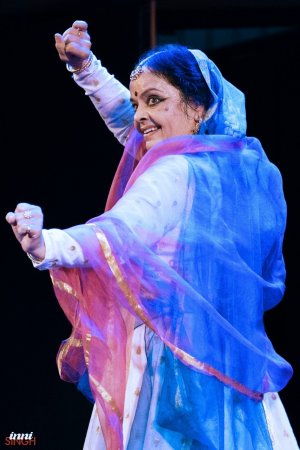 Prerana Shrimali (photo: Inni Singh) Prerana Shrimali's Kathak recital, based on Delhi's legendary Urdu poets, at the Deshmukh auditorium was one of its kind. She began with a verse of Amir Khusro, a renaissance man wearing many hats as poet, warrior, musician, royal courtier and a Sufi. Credited with having invented the sitar and the tabla, his verses covered many languages. Prerana began with his verses on love and beauty, "Mohe apne hi rang me rang le rangile, Tu to sahib mera mehboob eilahi, Jo tu mange rang ki rang ayi". The beloved offering her dupatta yearns to colour herself in the colour of the love, for which she offers her youth as wages (Mori jo ban girwi rakh lo). Prerana's dance in vilambit laya, set to raag Khamaach in Deepchandi taal, sung in savoured melody by Imran Khan, became a metaphor of colour of love and expression both sensuous and spiritual merging in one, its pace providing a spaciousness to the dancer to improvise at leisure, through 'thata' - an aspect of Kathak which receives cursory treatment in most recitals of the day. The interpretation of Ghalib's poetry as a Ghazal sung in Rageshree set to rupak taal, illustrated the poet's contrary moods - despair on one side and comic irony on the other. Celebrating love where even the footprints are seen by the beloved as the flowers of love, "Jahan tera naqsh ye kadam dekhte hain, k hayaban, k hayaban iram dekhte hain" and then the mood changes with Ghalib in the garb of a faqir looking at this tamasha of the obliging people. "Banakar fakiron ka ham bhes ga.." One was amazed at the way Prerana's angikabhinaya (bodily expression as against mukhabhinaya or facial expression) is so adept at conveying the mood. And the rhythmic punctuations forming a natural part of the dance tapestry without standing out as obvious expressions of technical virtuosity, show a dancer with complete mastery over the medium. With verses of Meer and Dagh finding place in the concluding pure dance item of the Tarana (believed to be a contribution of Amir) in teental and raga Bahaar, the nritta of Kathak was seen in full bloom. Says Meer, "Patta patta boota boota haal hamara jaane hai...." (Every leaf and the whole garden is aware of my feelings, barring you). And Dagh's narcissistic statement that while the Mehfil has everything, the one grave omission, is his not being there! After all the superbly rendered Tarana razzmatazz, the crowning artistic touch of great subtlety, bringing tears to the eyes, came after seconds of total silence (the singer just whispering the last line of Meer's poetry, "Sirhane Meer ke koi na bolo, ahista bolo, abhi tuk rote rote so gaya hai". Silence! For this is the final resting place of Meer who has just been laid to rest closing his eyes in eternal sleep. With a sensitive tablist in Pt.Fateh Singh Gangani, singer Imran Khan who is back to his old melodious self and hopefully will stay there, and fine instrumentalists Murad Ali Khan and Fateh Ali Khan on sarangi and sitar, Prerana insured herself an inspirational take-off point. Kalashram's Vasantotsav Photos courtesy: Kalashram Defying indifferent health, Pandit Birju Maharaj registered his presence right through the two day festival of Vasantotsav (Feb 22 & 23) at the Kamani, annually mounted by his institution Kalashram. This year's Kala Jyoti Samman title went to that most melodious of classical sitarists, Ustad Shahid Parvez Khan. Unfortunately, with the Shivaratri madness with every institution announcing a celebration, it was auditorium hopping which became the order of the day for many critics, taking in parts of happenings in Delhi. And one could only manage a sampling of the entire festival. 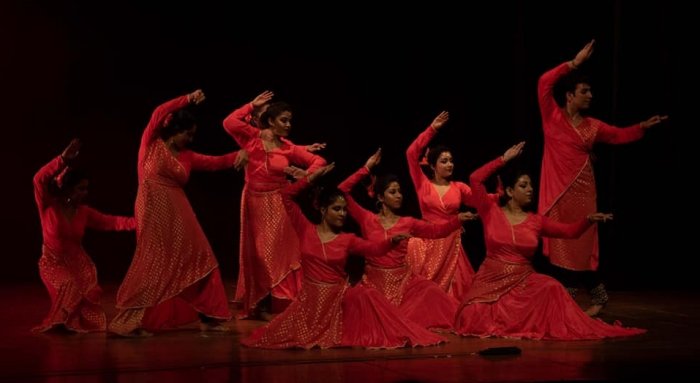 Luna Poddar's group 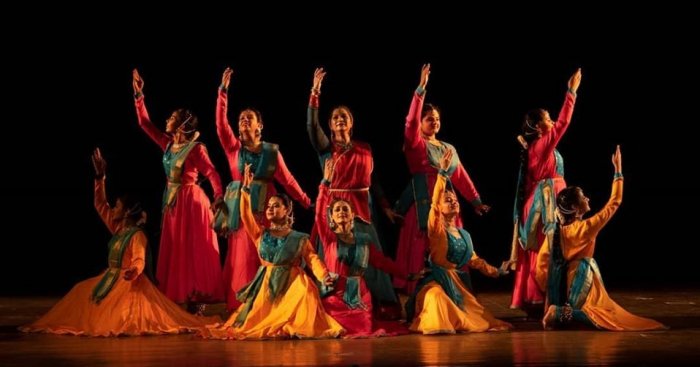 Vidya Deshpande's group Arriving towards the fag end of the group performance by Luna Poddar's Prerna Centre for Performing Arts heralding a start to the festival, I was in time to take in a correct if not outstanding performance by Abhijat Nritya Natya Sangeet Academy's Dhamar and Hori group performance by Vidyahari Deshpande Kathak Ensemble. "Bajat Taal Dhamar" choreographed by Pandit Birju Maharaj is based on his own music in the form of a Lakshangeet on taal Dhamar. He has created similar music compositions for all the different Kathak talas. This nritta part was followed by Hori wherein Kumar Gandharva's music composition has dance choreography set by late Rohini Bhate. In terms of group discipline, costume aesthetics of gold coloured skits with red dupattas, trim bodied dancers, I found the repertory group of Nandini Singh's Vaasuki Natyashala extremely well rehearsed in their chakkars and intricate footwork. Their Tarana in raag Bageshwari set to Jhaptaal, apart from the coordinated dancing, was well sung by Imran Khan with Babu Latif on the tabla and Ghulam Wariz on sarangi. 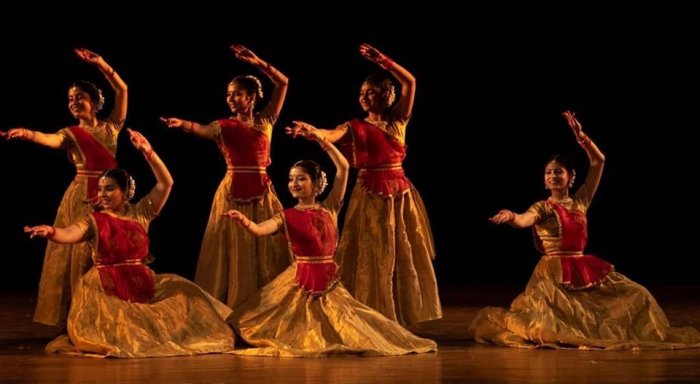 Kalashram  Saurav & Gaurav Mishra  Tribhuwan Maharaj & Rajni Chandleela with its interplay of rhythmic patterns of 12 (Ektaal), 10 (Jhaptaal) and 14 (Dhamar) had musical and non musical sounds in the music with a variety of instruments. Kalashram students Ipshita, Shinjini, Garima, Elisha, Shivani and Sunny presented what was conceived, choreographed with music also set by Pt Birju Maharaj. The entire next day was devoted to presenting young dancers of various gurus. In the Yugal Nritya devoted to duets, the young Saurav and Gaurav Mishra, students of Guru Pt Ravi Shankar Mishra, who belong to one of the reputed families of the Benares Gharana tradition, presenting Om Namah Shivaya as invocation in the Teental presentation, were infallible in footwork and rhythmic control in the drut laya. Rudra Shankar Misra provided parhant. It was real 'dhamaka' Kathak, they presented. A feature of this Vasantotsav was watching the third generation of Birju Maharaj's family performing. Son of Jaikishen Maharaj and grandson of Pt Birju Maharaj, Tribhuwan Maharaj representing the ninth generation in the Kalka-Bindadin line of Lucknow gharana, did a Kathak-Bharatanatyam duet Jathi Aarohan with his wife Rajni, a Bharatanatyam dancer trained under Justin McCarthy and Priya Srinivasan, presenting bandishes and matching teermanams in tisram, chatusram, khandam and misram. A pleasant dancer, Rajni however must develop a more pronounced 'araimandi'. 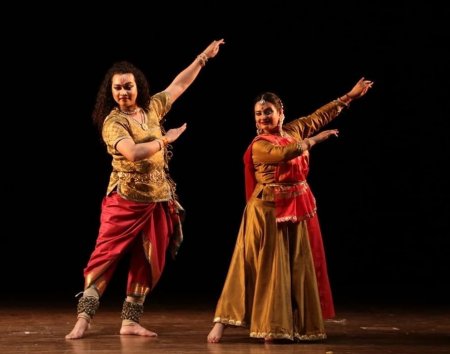 Vishal Krishna & Ragini 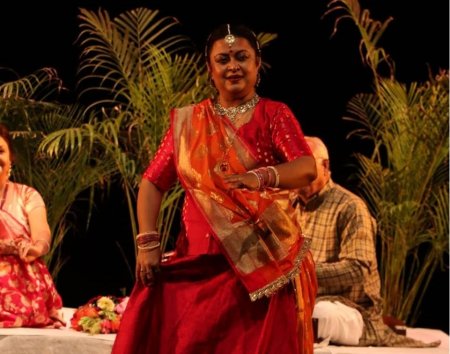 Mamta Maharaj Yet another of the maestro's grandchildren, Ragini, a Kathak dancer trained under aunt Mamta Maharaj, uncle Jaikishen Maharaj and father Deepak Maharaj, is growing up to be a very confident Kathak dancer. She partnered Vishal Krishna whose usual bodily dexterity with leaps and circles and squats not to speak of touching 'sama' in a full split seated on the ground, evoked adoring applause. One of the unusual presentations was Malini Awasthi's singing of Thumris, "Re la la tuma to karata bara jori" in Misra Kafi followed by 'Hori khelo mose Nandalal' in Misra Khambawati followed by a Dadra with Dharamnath on harmonium and Ramkumar Misra on tabla. To see a finale of a duet with her music and Maharaj's daughter Mamta Maharaj's abhinaya was interesting. Apart from running her own institution, Mamta is a teacher in Maharaj's school Kalashram.  Writing on the dance scene for the last forty years, Leela Venkataraman's incisive comments on performances of all dance forms, participation in dance discussions both in India and abroad, and as a regular contributor to Hindu Friday Review, journals like Sruti and Nartanam, makes her voice respected for its balanced critiquing. She is the author of several books like Indian Classical dance: Tradition in Transition, Classical Dance in India and Indian Classical dance: The Renaissance and Beyond. Post your comments Please provide your name and email id when you use the Anonymous profile in the blog to post a comment. All appropriate comments posted with name and email id in the blog will also be featured in the site. |